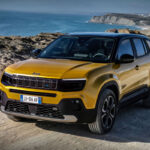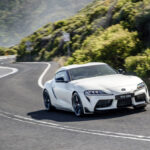For the past decade or so the world’s car companies have been searching for powertrains that provide the best of both worlds – elimination of the use of fossil fuel and exhaust emissions while still providing good on-road performance and driving range.
Two of the early adopters were Honda and Toyota who took the petrol/electric high ground with their Insight and Prius models. These reduced both fuel consumption and CO2 emissions but used a combination of petrol and batteries. Performance was reasonable and driving range excellent but both the engines relied on fossil fuel.
Toyota has now taken the next step with the production of its first hydrogen-based fuel cell vehicle (FCV). Called Mirai – appropriately it’s the Japanese word for ‘future’ – it is essentially an electric car, but with the electricity supplied by a fuel cell stack. Hydrogen stored in twin fuel tanks at 70 MPa (700 bar) at the rear of the vehicle is pumped into the mid-mounted fuel cell where it combines with air to generate electricity. The electricity is then supplied to an electric motor which powers the car. The only emission is water in the form of vapour via a rear exhaust pipe.
The range limitation which is a downside of most electric vehicles is less relevant to FCVs with Toyota quoting a range of up to 550 kilometres from Mirai. Refuelling of the hydrogen tanks takes between three and five minutes at a cost, according to Toyota, of about $60.
The motor generates maximum power of 113 kilowatts and 335 Newton metres.
Mirai is already on sale in Japan, the USA and a number of European countries but is still a long way off from arriving here. As with most environmentally friendly automotive innovations progress is being hampered by an almost total lack of support from successive Australian governments.
Mirai sells in the USA for around $US60,000.
The major stumbling block to the adoption of FCV technology is the availability of refuelling infrastructure. In an innovative move to spread the word about the new technology Toyota has built a portable refuelling station that will enable the three Mirai models currently in Australia to travel around the country. The refueller incorporates a generator and compressor mounted in a purpose-built trailer with space to also transport one of the cars and is attached to a Hino 700 prime mover.
Mirai is a front-wheel drive, four-door and four-seat sedan with body dimensions similar to those of Camry but is built on its own distinct platform. Boot capacity is 360 litres.
We were able to take Mirai for a short test drive out of Toyota’s southern Sydney headquarters. It’s essentially the same as the other EVs that we’ve driven in that it’s all-but silent. However there are some sounds from the air compressor and hydrogen recirculation pump. It does get the bonus of instant maximum torque.
There are two drive settings, Eco and Sport, with a claimed range of 550 kilometres in Eco mode.
Let’s hope that current and future governments of all persuasions will finally see the light and use some of the savings from the end of local-production subsidies to channel them into projects such as fuel cell technology.














